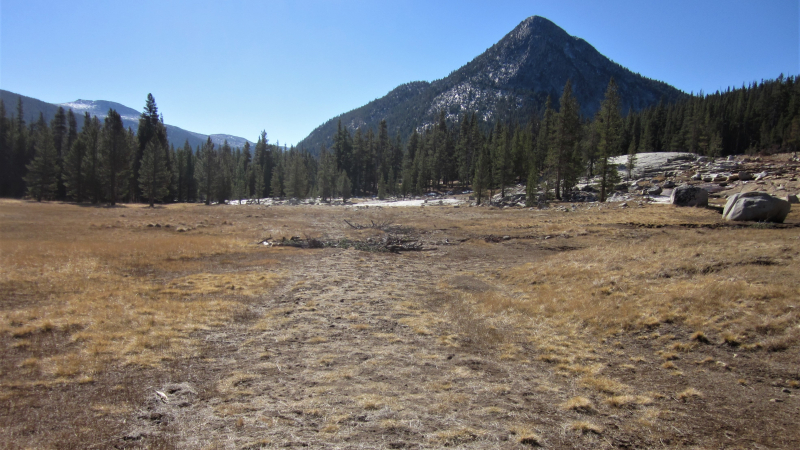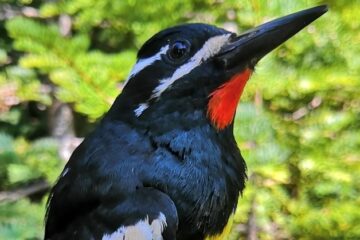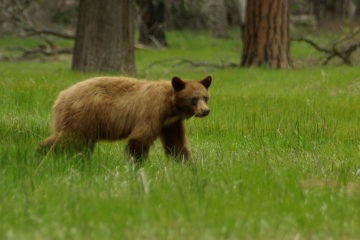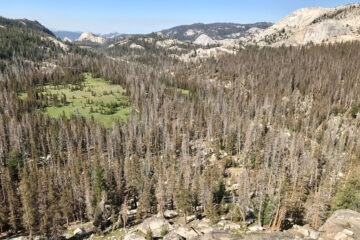On October 2, 1968, President Lyndon B. Johnson signed the National Trails System Act, with the stated goal of promoting “the preservation of, public access to, travel within, and enjoyment and appreciation of the open-air, outdoor areas and historic resources of the Nation.”
The original legislation established two long-distance national scenic trails: the Appalachian Trail, which stretches from Georgia to Maine, and the Pacific Crest Trail (PCT), which spans California, Oregon and Washington. Fifty years after that landmark act, we’re taking a look at the western part of its inaugural designees.
Nearly 70 miles of the PCT pass through Yosemite National Park, where it overlaps with another famous long-distance route: the John Muir Trail (JMT).
The PCT and JMT cross the park’s southeastern border together at Donohue Pass, just north of Mounts Lyell and Maclure, where you’ll find the last remnants of Yosemite’s glacial ice. From there, the united trails follow a fork of the Tuolumne River down into Lyell Canyon. As hikers trek north through the canyon toward Tuolumne Meadows, they pass through a biodiverse ecosystem that supports a variety of riparian, wetland and woodland species, including mule deer, black bears, and endangered Yosemite toads and Sierra Nevada yellow-legged frogs.
With its postcard-worthy Sierra scenery and world-famous trail(s), Lyell Canyon has become an understandably popular place not just for PCT and JMT thru-hikers, but also for other backpackers and day hikers. Horses and mules often tread through the canyon, too, carrying riders or backcountry supplies.
All that foot (and hoof) traffic has proven problematic for the canyon’s meadows. Trails that cut through wetlands are often … wet. Hikers and animals encountering sections of sodden, muddy trail step off into the adjacent meadow. That off-trail tramping squashes vegetation and carves out water-channeling ruts that disrupt natural hydrology.
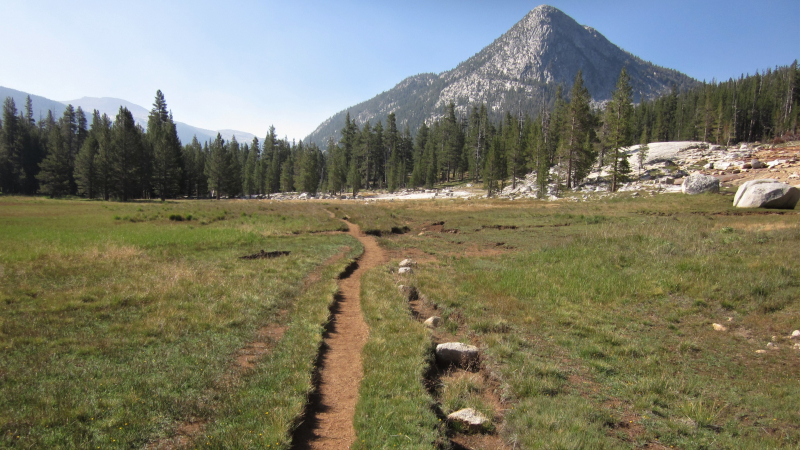
Deep ruts developed alongside the Pacific Crest/John Muir Trail in Lyell Canyon, forged by hikers and stock animals stepping off the trail to avoid mud and water.
What to do?
Option A: Send crews to the canyon to repair ruts and fix damaged trail sections. Wait for winter precipitation and poor drainage to re-create the problem. Repeat.
Option B: Relocate the trail upland, out of the meadow, and restore the wetland.
As you probably guessed, the park’s restoration experts went with B. Our donors have supported numerous grants to restore and protect the PCT/JMT and the Lyell Canyon ecosystem by rerouting the trail to drier, more durable ground and restoring habitat in its former footprint. This long-term solution ties back to the 1968 trails act: Moving the PCT/JMT helps ensure that future generations of hikers will be able to immerse in the canyon’s beauty and experience a healthy wetland habitat, without causing inadvertent harm.
How do you turn a trail back into a meadow? Through active restoration: Rather than simply closing the damaged section of the PCT/JMT and hoping for the best, crews are taking careful steps to reestablish natural topography, vegetation and water flow. Here’s how it works:
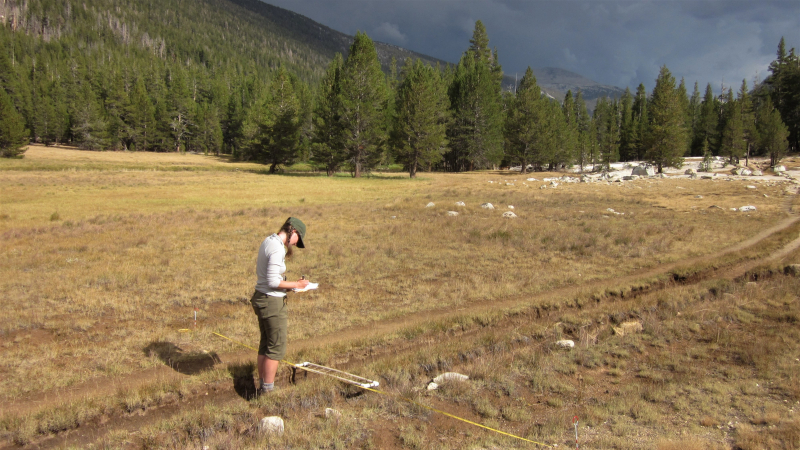
Start with surveys to assess the extent of trail ruts and their impact on the meadow ecosystem. Yosemite crews identified roughly 2.5 miles of the PCT/JMT that needed attention.
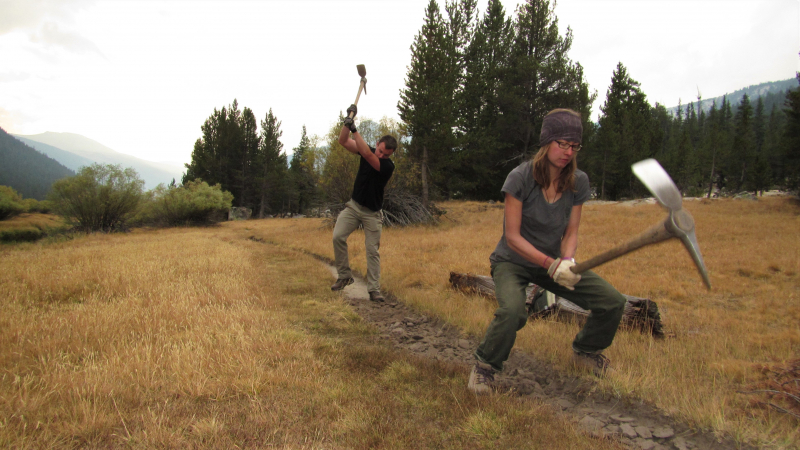
Dig in – literally. Thousands of human, horse and mule feet have trodden the trail and parallel ruts, leaving compacted soil in their wake. Loosening up the earth allows water to infiltrate the ground and helps new plants take root.
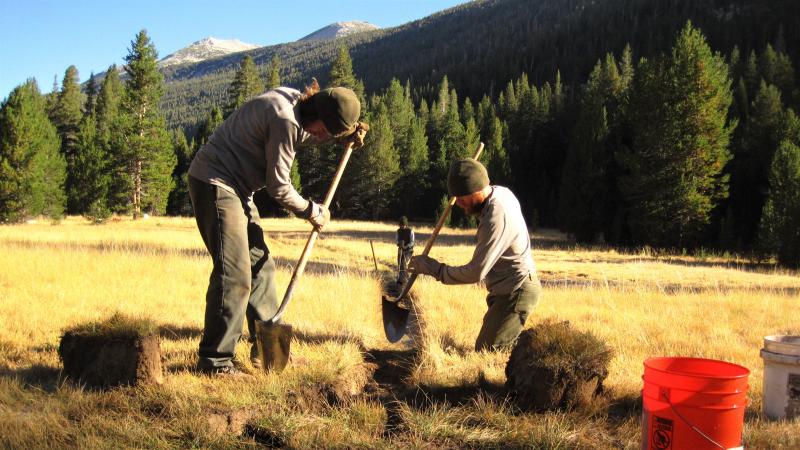
Salvage “plugs” of natural vegetation from the edges of to-be-relocated trail sections. Digging out the plugs, which will soon be replanted, helps obscure the outline of the closed route.
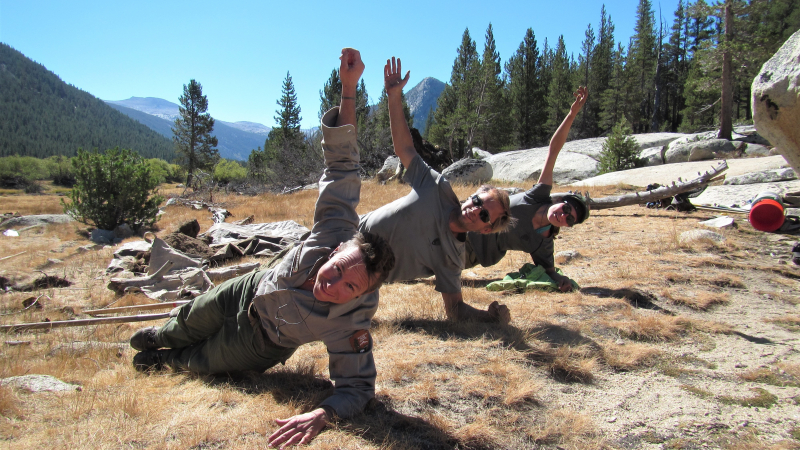
Take a stretch break. All that shoveling can tax your muscles!
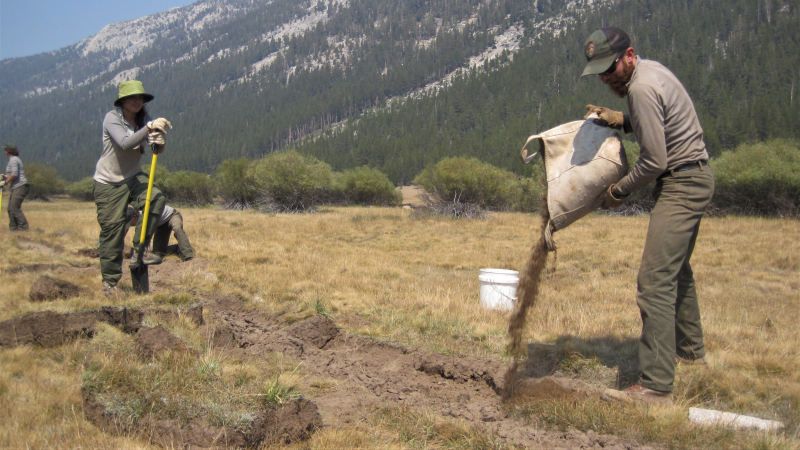
After replanting the plugs, use natural fill materials, such as soil and bits of wood, to close gaps and restore natural topography.
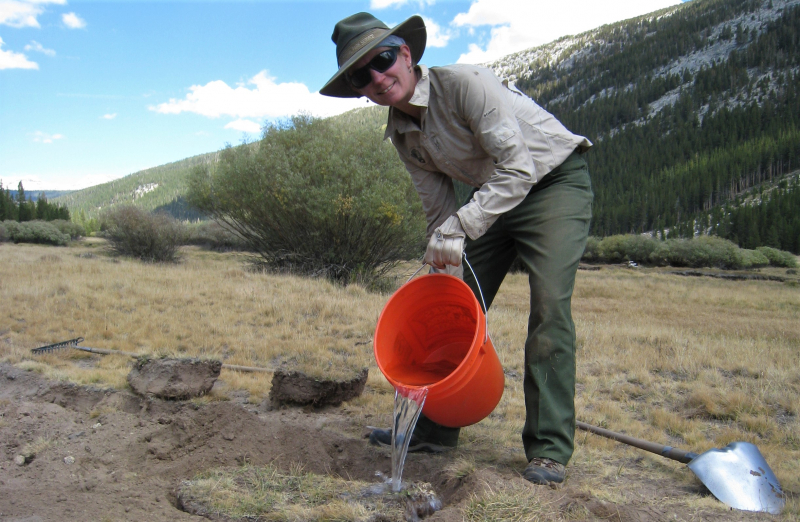
Water newly planted plugs to make sure they’re happily hydrated in their new homes.
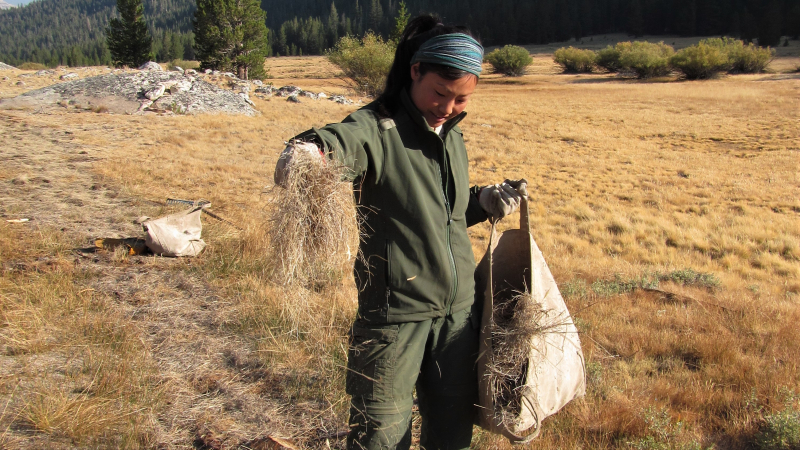
Add a layer of duff (plant material) to help retain soil moisture and camouflage the restored area.
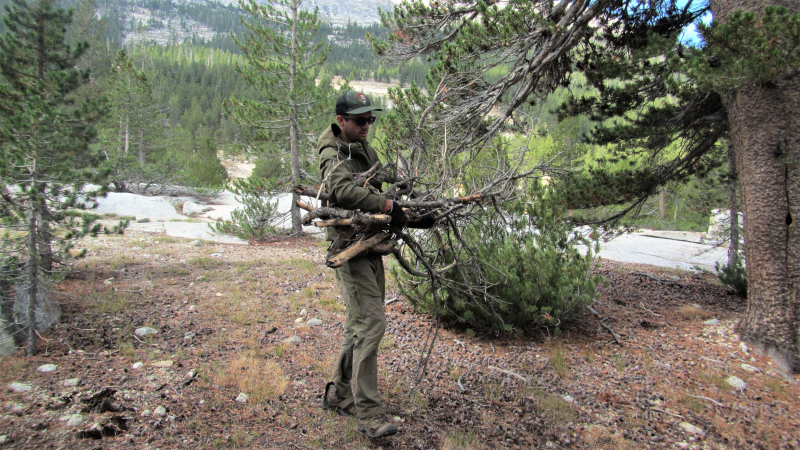
Obstruct the old trail with logs, sticks, rocks and vegetation.
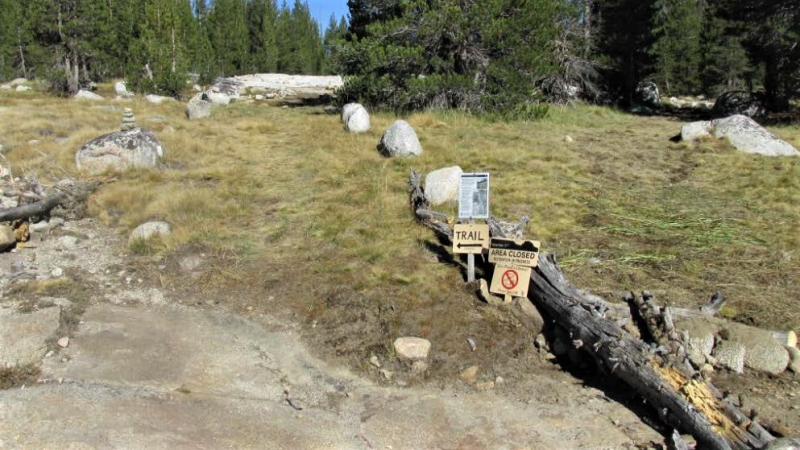
Point people toward the new trail, using temporary signs and physical barriers.
Those actions add up. Since 2013, crews have restored more than 85,000 square feet of meadow in Lyell Canyon, and have built approximately 2 miles of the new PCT/JMT route. With support from our donors, this much-needed work is preserving a beloved section of an iconic trail, while protecting the “open-air” resource to which it provides access.
You don’t have to go far to experience Yosemite’s long-distance trails. From the Tuolumne Meadows Lodge, a short (under a mile) stroll on the PCT/JMT will get you to a scenic set of wooden bridges, with views of rushing water and lush forest-lined meadow. If you’re feeling more ambitious, you can tackle the 24-mile round-trip trek to Donohue Pass — or carve out a few weeks or months for a thru-hike.
If you do find yourself in Lyell Canyon this year, look for evidence of recent restoration efforts, keep an eye out for crews at work (thanks to a 2018 donor-supported grant), and wish the PCT a happy jubilee!
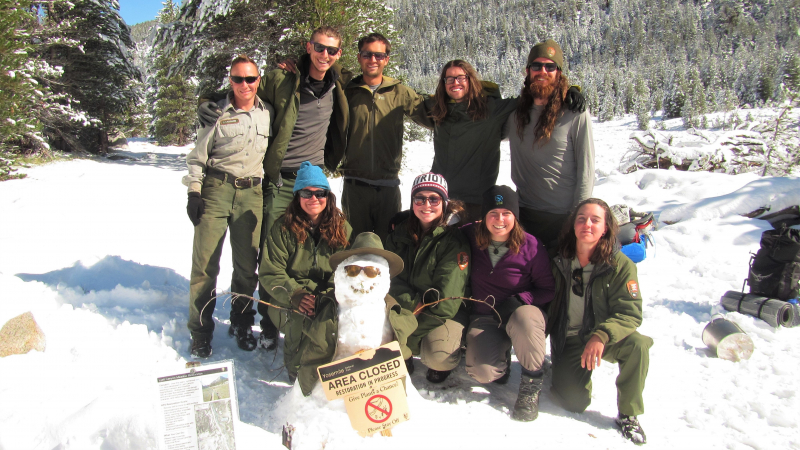
Thank you to the many Yosemite employees and volunteers (and snow-people) who have played a part in restoring and preserving Lyell Canyon and the Pacific Crest/John Muir Trail!
A few fun stats:
- The Pacific Crest National Scenic Trail covers 2,659 miles from the U.S.-Mexico border (near Campo, California) to the U.S.-Canada border (near Manning Park, British Columbia). The PCT was completed in 1993, 25 years after its designation as National Scenic Trail.
- The John Muir Trail covers 210.4 miles, from Happy Isles, in Yosemite Valley (elevation 4,000 ft.), to Mount Whitney (elevation 14,505 ft), and overlaps with the PCT for approximately 160 miles. The JMT was completed in 1938, though construction started in 1915 (and scouting began in the late 1800s).
- The National Trails System includes more than 1,000 scenic, historic, recreational, and connecting-and-side trails, and covers nearly 60,000 miles of terrain.
All images courtesy of NPS.

